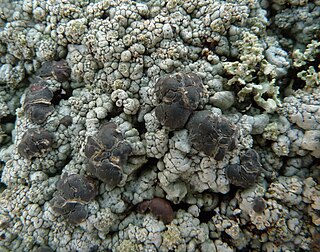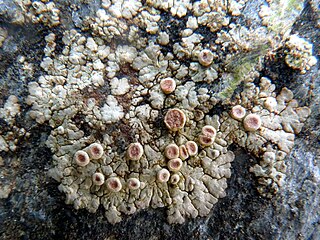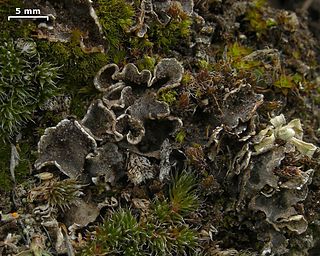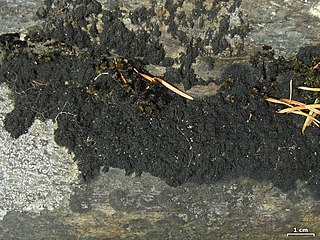
Parmelia is a genus of medium to large foliose lichens. It has a global distribution, extending from the Arctic to the Antarctic continent but concentrated in temperate regions. There are about 40 species in Parmelia. In recent decades, the once large genus Parmelia has been divided into a number of smaller genera according to thallus morphology and phylogenetic relatedness.
Irwin M. Brodo is an emeritus scientist at the Canadian Museum of Nature, in Ottawa, Ontario, Canada. He is an authority on the identification and biology of lichens. Irwin Brodo was honored in 1994 with an Acharius Medal presented to him by the International Association for Lichenology.

Caloplaca is a lichen genus comprising a number of distinct species. Members of the genus are commonly called firedot lichen, jewel lichen. gold lichens, "orange lichens", but they are not always orange, as in the case of C. albovariegata. The distribution of this lichen genus is worldwide, extending from Antarctica to the high Arctic. It includes a portion of northern North America and the Russian High Arctic. There are about thirty species of Caloplaca in the flora of the British Isles.

Trapeliopsis is a genus of lichenized fungi in the family Trapeliaceae. It contains 20 species. The genus was circumscribed in 1980 by Hannes Hertel and Gotthard Schneider, with Trapeliopsis wallrothii designated as the type species.

Placopsis is a genus of lichenized fungi in the family Trapeliaceae.

Fuscidea is a genus of crustose lichens in the family Fuscideaceae. It has about 40 species. The genus was circumscribed in 1972 by lichenologists Volkmar Wirth and Antonín Vězda, with Fuscidea aggregatilis assigned as the type species.

Lichens are symbiotic organisms made up of multiple species: a fungus, one or more photobionts and sometimes a yeast. They are regularly grouped by their external appearance – a characteristic known as their growth form. This form, which is based on the appearance of vegetative part of the lichen, varies depending on the species and the environmental conditions it faces. Those who study lichens (lichenologists) have described a dozen of these forms: areolate, byssoid, calicioid, cladoniform, crustose, filamentous, foliose, fruticose, gelatinous, leprose, placoidioid and squamulose. Traditionally, crustose (flat), foliose (leafy) and fruticose (shrubby) are considered to be the three main forms. In addition to these more formalised, traditional growth types, there are a handful of informal types named for their resemblance to the lichens of specific genera. These include alectorioid, catapyrenioid, cetrarioid, hypogymnioid, parmelioid and usneoid.

Megaspora is a genus of lichens in the family Megasporaceae. The genus was described in 1984 with M. verrucosa as the type species.

Elke Mackenzie, born Ivan Mackenzie Lamb, was a British polar explorer and botanist who specialized in the field of lichenology. Beginning her education in Edinburgh, Scotland, Mackenzie later pursued botany at Edinburgh University, earning a Bachelor of Science degree in 1933 and a Doctor of Science in 1942. In the two years she was involved in Operation Tabarin, a covert World War II mission to Antarctica, she identified and documented many lichen species, several of them previously unknown to science.
Rolf Santesson (1916–2013) was a Swedish lichenologist and university lecturer. He was awarded the Acharius Medal in 1992 for his lifetime contributions to lichenology.
Per Magnus Jørgensen is a Norwegian botanist and lichenologist, and Professor Emeritus of systematic botany at the University of Bergen. He is known for his work on the lichen families Pannariaceae and Collemataceae. Jørgensen was awarded the Acharius Medal in 2021 for his lifetime contributions to lichenology.

Peltigera lepidophora, commonly known as the scaly pelt, is a species of foliose lichen in the family Peltigeraceae. It was first described by Finnish lichenologist Edvard August Vainio in 1878 as a variety of Peltigera canina. German botanist Friedrich August Georg Bitter promoted it to species status in 1904.

Ephebe lanata is a species of filamentous lichen in the family Lichinaceae, and the type species of the genus Ephebe. The lichen was first described as a new species by Swedish taxonomist Carl Linnaeus in his seminal 1753 work Species Plantarum, as Lichen lanatus. Finnish lichenologist Edvard August Vainio transferred it to Ephebe in 1888. In North America, it is known colloquially as the "rockshag lichen".

Ochrolechia africana, commonly known as the frosty saucer lichen, is a species of crustose and corticolous (bark-dwelling) lichen in the family Ochrolechiaceae. It is a widely distributed species, found in tropical and subtropical areas of southern Africa, Asia, Australia, North America, and South America. The lichen is characterized by the presence of a white "frosty" or powdery apothecia.
Henricus (Harrie) Johannes Maria Sipman is a Dutch lichenologist. He specialises in tropical and subtropical lichens, and has authored or co-authored more than 250 scientific publications. He was the curator of the lichen herbarium at the Berlin Botanical Garden and Botanical Museum from 1983 until his retirement in 2010.

The following outline provides an overview of and topical guide to lichens.

Xanthoria ulophyllodes is a species of mostly saxicolous (corticolous-dwelling) lichen in the family Teloschistaceae. It was formally described as a new species in 1931 by Finnish lichenologist Veli Räsänen. In North America, one vernacular name for the species is powdery sunburst lichen.
Placomaronea lambii is a species of saxicolous (rock-dwelling) lichen in the family Candelariaceae. It occurs at high altitudes in Argentina, Ecuador, and Peru, where it grows on acidic rocks in open habitats.
Usnea lambii is a small species of fruticose lichen in the family Parmeliaceae. It was first formally described as a new species in 1954 by Henry Imshaug. It has a bipolar distribution, that is, it occurs at both of Earth's polar regions. It is also found at high elevations in Mount Rainier National Park in Washington state, where it was first discovered.













